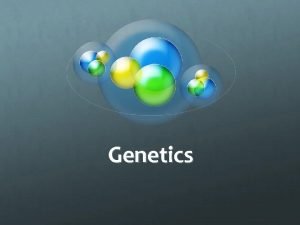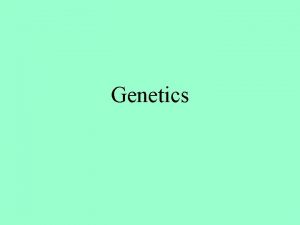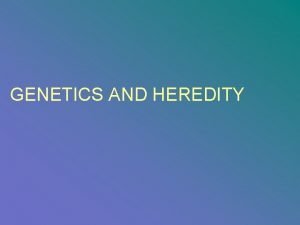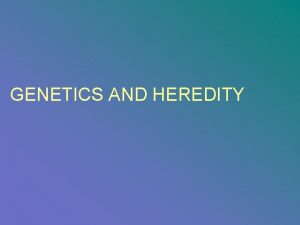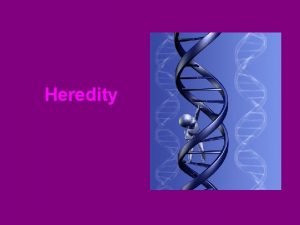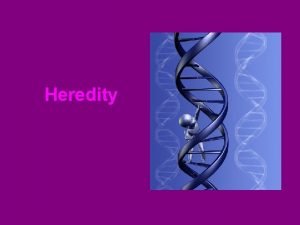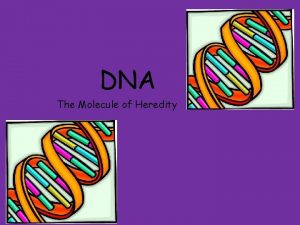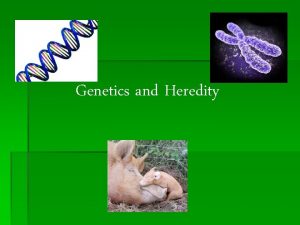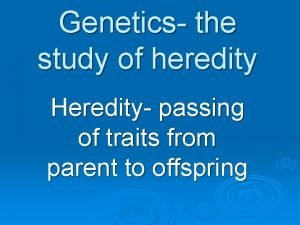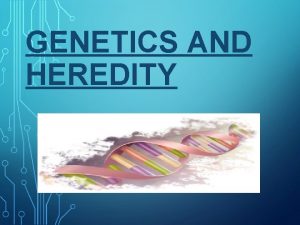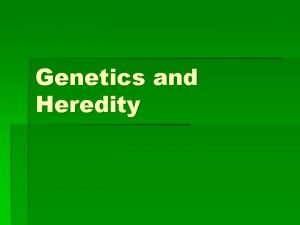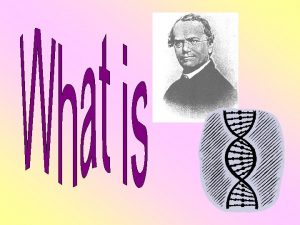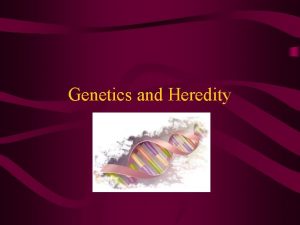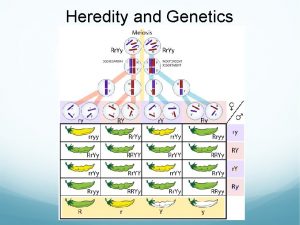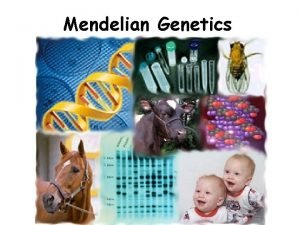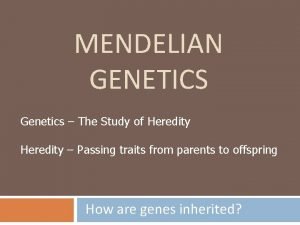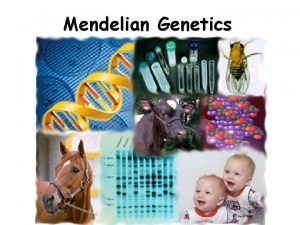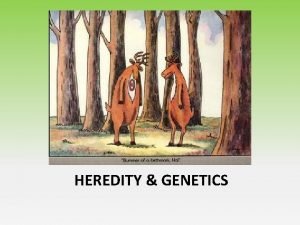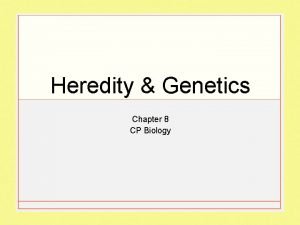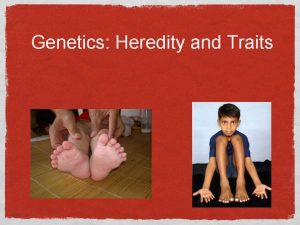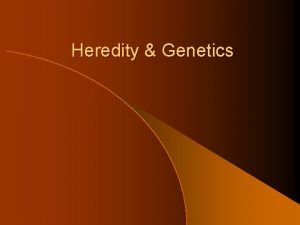HEREDITY GENETICS HEREDITY Heredity Is the passing of












































- Slides: 44

HEREDITY GENETICS

HEREDITY • Heredity Is the passing of traits from parents to offspring. • Genes on chromosomes control the traits that show up in an organism. • The different forms of a traits that a gene may have are alleles.

Chromosome

CELL DIVISION • During meiosis a pair of chromosomes separates and the alleles move into separate sex cells. • Each sex cell now contains one allele for each trait. • The study of how traits are inherited is genetics.

Mitosis

Meiosis

Gregor Mendel the father of Genetics • • Mendel was the first to use mathematics of probability to explain heredity and to trace one trait for several generations. Hybrid receives different genetic information for a trait from each parent.

Mendel and Beans Experiment

ALLELES • Dominant allele covers up or dominates the other. • Recessive allele the trait seems to disappear. • Probability helps you predict the chance that something will happen.

Dominant and Recessive Allele

GENETICS • Punnet square can help you predict what an offspring will look like. • Upper case letters stand for dominant alleles • Lowercase letters stand for recessive alleles. • Genotype the genetic make up of an organism.

Punnet Square

GENETICS • Homozygous an organism with two alleles for one trait that are the same ( written TT) • Heterozygous an organism with two alleles for one trait that are different ( written Tt) • Phenotype the way an organism looks and behaves as a result of its genotype.

Phenotype

Genotype

Genetics since Mendel • Incomplete dominance • Neither allele for a trait is dominant. • The phenotype produced is intermediate between the two homozygous parents. • Multiple alleles • More than two alleles that control a trait are called multiple alleles. • Traits controlled by multiple alleles produce more than three phenotypes.

Incomplete Dominance

Incomplete Dominance

Polygenic Inheritance • A group of gene pairs acts together to produce a trait, which creates more variety in phenotypes. • Many human traits are controlled by polygenic inheritance, such as hair and eye color.

Polygenic Inheritance

Polygenic Inheritance

MUTATIONS • Mutations are genes that are altered or copied incorrectly. • A mutation can be harmful, beneficial or have no effect. • Chromosome disorders caused by more or fewer chromosomes than normal. • Down’s syndrome caused by an extra copy of chromosome 21.

Normal Karyotype

Trisomy 21

Down Syndrome /Trisomy 21

Down Syndrome /Trisomy 21

Cleft Lip and Palate

Trisomy 18

Trisomy 18

Trisomy 18/Edwards Syndrome

Recessive Genetic Disorders • Both parents have a recessive allele responsible for the disorder and pass it to their child. • Because the parents are heterozygous, they don’t show any symptoms. • Cystic Fibrosis is a homozygous recessive disorder.

Cystic Fibrosis

Cystic Fibrosis

Cystic Fibrosis

Hutchinson–Gilford Progeria Syndrome

CAUSE • • • The gene LMNA encodes a protein called prelamin A. Prelamin A has a farnesyl group attached to its end. Farnesyl group is removed from prelamin A. Farnesyl group remains attached to prelamin A. Normal form is called prelamin A. • Abnormal form of prelamin A is called progerin. Prelamin A is not anchored to the nuclear rim. • Progerin is anchored to the nuclear rim. Normal state of the nucleus. Abnormally shaped nucleus.

Sex Determination • Chromosomes that determine the sex of an organism are XX in females and XY in males. • Females produce eggs with an X chromosomes only. Males produce sperm with either an X or a Y chromosome.

Sex-linked disorders • An allele inherited on an X or Y chromosome is a sex-linked gene. • Color blindness is a sex- linked disorder caused by a recessive allele on the X chromosome. • A pedigree follows a trait through generations of a family.

Advances in Genetics • Genetic Engineering is changing the arrangement of DNA that makes up a gene. • Recombinant DNA. • Insertion of a useful segment of DNA into a bacterium. • Insulin is a made by genetically engineered organisms.

Gene therapy • A normal allele is placed into virus, which delivers the normal allele when it infects its target cell. • May be used to control cystic fibrosis or other genetic disorders. • Genetically engineered plants created by inserting the genes that produce desired traits in one plant into a different plant.

Sex- linked trait on the X chromosome is color blindness Xc • Normal female • Normal male • Carrier female • Color-blind male

Sex-linked chromosome

Questionnaire 1. What is the genotype of the first generation female person 4 ? • Xc X 2. What is the genotype of the first generation male, person 5 ? Xc Y 3. What is the probability in percent of person 6 passing on the color-blind trait ? 0%

Questionnaire 8. What is the probability in percent of person 7 passing on the color-blind trait? 50 % 9. Person 5 is color-blind. However, his sons do not have this condition. What accounts for this? Sons inherited only the Y chromosome from their father.
 Genetics is the study of heredity and variation
Genetics is the study of heredity and variation Chapter 17 lesson 2 heredity and genetics
Chapter 17 lesson 2 heredity and genetics Số.nguyên tố
Số.nguyên tố Trời xanh đây là của chúng ta thể thơ
Trời xanh đây là của chúng ta thể thơ đặc điểm cơ thể của người tối cổ
đặc điểm cơ thể của người tối cổ Gấu đi như thế nào
Gấu đi như thế nào Các châu lục và đại dương trên thế giới
Các châu lục và đại dương trên thế giới ưu thế lai là gì
ưu thế lai là gì Thẻ vin
Thẻ vin Tư thế ngồi viết
Tư thế ngồi viết Thế nào là hệ số cao nhất
Thế nào là hệ số cao nhất Bàn tay mà dây bẩn
Bàn tay mà dây bẩn Lp html
Lp html Từ ngữ thể hiện lòng nhân hậu
Từ ngữ thể hiện lòng nhân hậu Tư thế ngồi viết
Tư thế ngồi viết Cách giải mật thư tọa độ
Cách giải mật thư tọa độ Ví dụ giọng cùng tên
Ví dụ giọng cùng tên Tư thế worm breton
Tư thế worm breton Thơ thất ngôn tứ tuyệt đường luật
Thơ thất ngôn tứ tuyệt đường luật Khi nào hổ mẹ dạy hổ con săn mồi
Khi nào hổ mẹ dạy hổ con săn mồi đại từ thay thế
đại từ thay thế Diễn thế sinh thái là
Diễn thế sinh thái là Các châu lục và đại dương trên thế giới
Các châu lục và đại dương trên thế giới Vẽ hình chiếu vuông góc của vật thể sau
Vẽ hình chiếu vuông góc của vật thể sau Bổ thể
Bổ thể Làm thế nào để 102-1=99
Làm thế nào để 102-1=99 Thế nào là mạng điện lắp đặt kiểu nổi
Thế nào là mạng điện lắp đặt kiểu nổi Lời thề hippocrates
Lời thề hippocrates Vẽ hình chiếu đứng bằng cạnh của vật thể
Vẽ hình chiếu đứng bằng cạnh của vật thể Chúa yêu trần thế
Chúa yêu trần thế Quá trình desamine hóa có thể tạo ra
Quá trình desamine hóa có thể tạo ra Khi nào hổ con có thể sống độc lập
Khi nào hổ con có thể sống độc lập Dạng đột biến một nhiễm là
Dạng đột biến một nhiễm là Công thức tính độ biến thiên đông lượng
Công thức tính độ biến thiên đông lượng Nguyên nhân của sự mỏi cơ sinh 8
Nguyên nhân của sự mỏi cơ sinh 8 Tỉ lệ cơ thể trẻ em
Tỉ lệ cơ thể trẻ em Phản ứng thế ankan
Phản ứng thế ankan Thiếu nhi thế giới liên hoan
Thiếu nhi thế giới liên hoan Tia chieu sa te
Tia chieu sa te điện thế nghỉ
điện thế nghỉ Một số thể thơ truyền thống
Một số thể thơ truyền thống Các môn thể thao bắt đầu bằng từ đua
Các môn thể thao bắt đầu bằng từ đua Hình ảnh bộ gõ cơ thể búng tay
Hình ảnh bộ gõ cơ thể búng tay Hệ hô hấp
Hệ hô hấp Passing bablok
Passing bablok













































